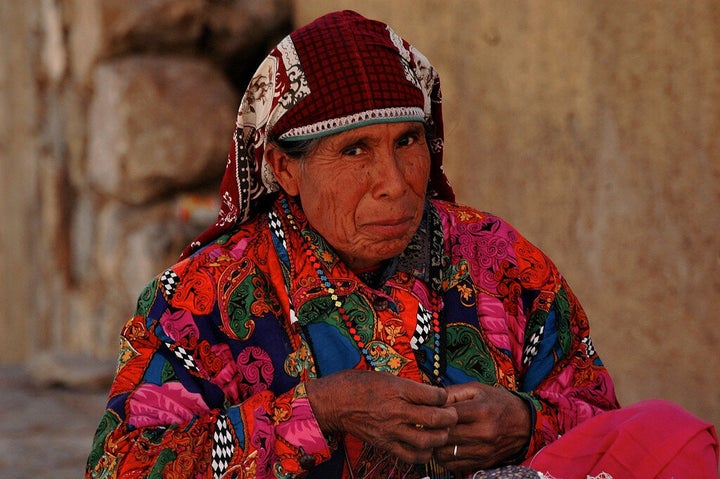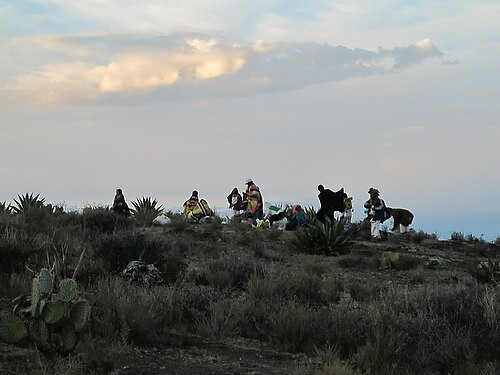
Note: This is the third in a series of articles, "Battle for the Birthplace of the Sun," reporting from the Sierra of Catorce on the historic pilgrimage of the Huicholes to their threatened sacred site of Wirikuta. See the first two parts here.
REAL DE CATORCE, Mexico -- They came by the hundreds from the Western Sierra Madre, native Wixarika or Huichol people on a spiritual quest, seeking to consult with the spirits of their ancestors and of the land where their world began. They came in their ceremonial dress, colorfully embroidered with their sacred symbols of the deer, the eagle and the peyote. They came with offerings they had fashioned from beads and gourds and beeswax, offerings they had made precious with their love and their prayers, as their forebears had done for centuries.
This year, however, would be vastly different from years past. This year, the sacred lands of Wirikuta lay under the shadow of an uncertain future. Vast swaths of the protected, UNESCO-recognized reserve had been conceded to Canadian mining companies, and hundreds of hectares had been bulldozed by agro-industrial companies. This year they were responding to a call that ran through all their communities, spread out through the Sierra Madre over four states: The candles of life were dying, and they would come together there to pray for their renewal.
What was different about this ceremony -- besides the context of the proposed mines -- was that they would converge at the Cerro Quemado, the mountain said to be the birthplace of the sun, and perform the ceremony together, instead of coming in small groups throughout the year. Normally, each of their ceremonial centers would send its own mara'akame or shaman and delegates separately, performing a series of intimate rituals in sacred sites all along the way, each group in its own traditional way. The other difference is that we would -- perhaps -- be allowed to attend.
The Huichols are one of the most vital traditional peoples remaining in the Americas, in part because their intricate and carefully guarded rituals, designed centuries ago in order to maintain a living and reciprocal relationship with nature, are only rarely opened to outsiders -- or even to Huichols from other communities.
That is how it came to be that the night of Feb. 6, the Cerro Quemado came alive with the songs of more than 800 Wixarika maraka'ate or shamans and their followers, connecting with the essences of life found here and praying to their deities in an unprecedented peritaje espiritual or spiritual consultation for guidance. And that is why, for the first time, dozens of teiwaris or non-Huichol dignitaries, activists and members of the media were sent special invitations to attend the event.
The idea was that we would wait at the foot of the mountain and be accompanied by a Huichol shaman in a special ceremony throughout the night as the elders on the peak communicated with their ancestors, their deities and the "essences of life" and awaited a response to their question: What should we do about the threats to Wirikuta?
It might happen that we would be invited up to the peak during the night to join the ceremony. Or it might happen that we would wait until the sunrise, when the maraka'ate (mara'akames) would come down to share with us the message they had received.
It was nearly sundown when I started up the mountain on horseback, along with Wirikuta Defense Front leader Carlos Chavez and his family. All along the way we passed small groups of Huichol pilgrims, making the two-mile hike up into the mountains on foot, laden with food and other supplies for the night ahead. We arrived at the casita, a round stone house at the base of the Cerro Quemado, just as the sun was going down. A phalanx of videographers lined the top of the first peak, shooting the pilgrims and visitors as they made their way up, and people were building fires, setting up tents and settling in for the night.
I waited anxiously with other journalists and invited guests, shivering in the below-freezing temperatures, to see whether we would actually be allowed to attend the ceremony. The other concern was whether the predicted rain would come during the night, something we teiwaris weren't sure we could endure.
For the moment, we watched as the fog arose over the desert below, creating a sea of white that extended for miles across the valley, and made conversation. The word came down to us that the elders were facing a tremendous task in coordinating their ceremony with each other and that they would need space and time to connect with their deities. We were being asked to stay below.
Disappointment ran through the crowd like a current, but the night was long, and many surprises awaited.
At about 10 p.m. the message came down that the media and invited guests would be allowed to come up for a limited time, but that we were to stay silent and not take any photographs. We lined up in single file and made our way up the mountain one-by-one in silence.
I emerged at the top to see the ridgetop sparkling with campfires all along its spine. A brilliant full moon shone over the sea of clouds below. At the center, in the concentric circle of stones called Tatewari-ta, the place of Grandfather Fire, about a dozen maraka'ate milled about. Most wore their broad-brimmed hats covered in eagle feathers, antenna that capture and amplify the messages sent from their deities. Others were wrapped in blankets to shield them from the bitter cold. All wore their thin cotton ceremonial clothing, slim protection from the rising winds. Many had been walking in pilgrimage for days, going without sleep and very little food, and had been caught in an icy downpour in the late afternoon -- a much-needed rainstorm in this drought-afflicted desert that many here believe that their ceremonies had invoked.
I huddled with anthropologists Paul Liffman and Johannes Neurath, shivering in our multiple layers of sweaters, coats, gloves and socks, and marveling at the energy and the nonchalance of the lightly clad Huichols. Soon the maraka'ate assembled and the plaintive wail of the Wixarika fiddles began to ring out in the darkness. The chants of the maraka'te rose on the wind; the ceremony had begun.
All throughout the long night these priests of ecology, as Liffman called them, sang their entreaties to the spirits that inhabit this place, an improvisation of melodies from different villages and different eras in time. They conducted their ancestral dialog with Grandfather Fire, an intermediary between the maraka'te and their deities. The sacramental peyote they had hunted in the desert the day before was working its magic. The hours passed in a blur and I huddled exhausted near a fire on the ridge, dozing for a few moments before I felt a shift in the wind. I sensed something was happening and returned to the fire to find a change in the energy.
The mara'akate had risen to their feet and began to dance, a rhythmic and upbeat shuffle of the feet, a forward-and-back movement that warmed the body and the soul. Soon the whole crowd was moving in unison, Huichols at the center, visitors on the edge. The cold began to dissipate and the joyful rhythm beat back the fatigue.
Surprised at the upbeat mood given the gravity of the situation, I commented on the apparent levity to Johannes Neurath. "Of course," responded Neurath, who has observed numerous such ceremonies over the years. "If you want the gods to come to your ceremony, you have to make it interesting. They're not going to come to a boring ceremony."
At the appointed time, a calf that had been waiting on the sidelines was brought to the center and the maraka'ate prayed over him, asking him to surrender his spirit for the well-being of humankind. The sacrifice was quick and as gentle as a sacrifice can be. The poor beast bleated softly once, twice, and kicked its small legs a couple of times before giving up the ghost. Soon its blood was being offered along with heartfelt prayers to the five directions.
More dancing, more singing. A sense of timelessness enveloped us. I went up the ridge to the fire being tended by a group of visitors from the Native American Church and a Mexican counterpart called the Nierika Center. Sandor Iron Rope, vice president of the Native American Church and a Lakota from South Dakota who said he had come to pray with his Wixarika brothers, looked out over the sea of clouds and the yucca trees that stood out like surreal feathered sentinels on the horizon.
"They look like the Wixarika people with their feathered hats," he observed. "They are guardians of this place." I suddenly realized it was true; I had had the sensation of being surrounded by gentle spirits, and now I understood the reason why.
"I wonder how the deities are feeling about all of this," I mused, looking around at the varied collection of humanity strewn over the mountaintop, observing the intensely private ritual of a reclusive people communicating with their gods.
"Oh, I think they're very happy," said Armando Loizaga, founder of the Nierika Center, a center for the study of sacred plants near Mexico City who has worked with the Huichols and other indigenous groups for many years.
"How can you tell?" I asked.
"Well, for one thing, there was the gentleness of the sacrifice - that was a good sign. For another, we've been blessed with a clear night full of stars. And for another, here we all are. We were allowed to be here, and that's a tremendous gift."
By now the ridge was strewn with the bodies of the unconscious, Wixarika and teiwari alike, who had succumbed to the temptation of sleep. But hundreds continued to dance to the mesmerizing chants of the maraka'ate, and the moon continued its slow descent.
Finally the sun began to brighten the eastern sky, and we were given permission to photograph a few moments of the ceremony. A frenzy of photographers converged on the ring of stones and clicked madly until an irate mara'akame shooed us away and ordered the cameras to cease. Eventually a procession began to make its way up the south ridge to a small house and an offering on the summit, where they centered their prayers once again and made their offerings.
It was mid-morning before the mara'akate and traditional leaders of the communities met in the center to discuss, in their native Wixarika tongue, the meaning of the message they had been given. And it was nearly noon before they assembled there on the circle of Tateiwari-Ta to share their vision with the world.
"They are sad, and they ask, with tears, weeping and pain, that it not be done, that they not tear out the heart, that they not take out the blood of this sacred mountain," said Maximino Muñoz, Wixarika leader from Paso de Alicia, Nayarit.
He was translating the words of Mara'akame Eusebio de la Cruz of Santa Catarina, Jalisco, who delivered the message from the deities in his native tongue.
Perhaps more importantly, he said, the gods had entreated them at every ceremony along the way on their pilgrimage, and the same message kept coming back to them. "They asked that all the Wixarika people be united to defend this place, And they asked that all humban beings, even the person who invades or destroys this sacred place, be united with us."
It was a strong message for a people that has been bitterly divided for more than two decades, with territorial and other disputes breeding rancor between the communities. It was also an indication, along with the decision to permit us to join them on the night of this ritual, of a new openness on the part of the Wixarika people to the outside world.
The ceremony was a trial by fire for the Wixarika leaders as well as for the Wirikuta Defense Front, the network of groups that are supporting them, said Eduardo Guzman, a judge in the desert community of Margaritas and a leader in the movement.
"Finally the word came with the coming of the dawn: They had passed the test and ended with a great unity, a great coinciding of ideas," he said. "It gives us hope that together we can form a much stronger force to impede the destructive and damaging projects that threaten Wirikuta. I leave with a great happiness and a great sense of hope that it's something that can be done."
Paul Liffman stopped by to share his impressions on his way out of town. For him, the event has a broader significance, not just for the people of rural Mexico, but for the world.
"The Huichols are positioned as priests of the rain who benefit the entire world -- and that's why the mine represents such a great threat, because they are trying to be a type of ecological priesthood and everything is at stake. The fact is that we live in an epoch of planetary desiccation due to climate change, and the respect for water that is completely implicit in this ritualization of the acquisition of water of a mountain teaches us to have a relationship of respect and honor of the natural elements, which they treat as divinities. The springs are the earthly corporalization of the ancestors.
Everyone here, including those who are in favor of the mines, believes that the Huicholes bring the rain. And now it hasn't rained in 14 months and suddenly it rains with the arrival of an unprecedented bunch of leaders of the ceremonial centers. They've always made the argument they are an essential link for the ecological reproduction not only of the region, but for the world."
The sun shone on his departure and that of the hundreds of pilgrims and their guests. As I write this piece, the night has fallen on Real de Catorce and the town is silent once again - except for the gentle patter of a steady rain.
For more information, see www.wirikutadefensefront.org and www.theesperanzaproject.org.
Created with Admarket's flickrSLiDR.
This post has been modified since its original publication.

